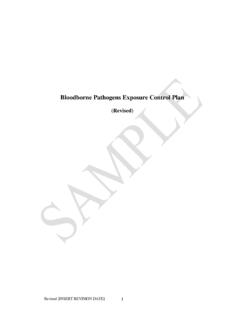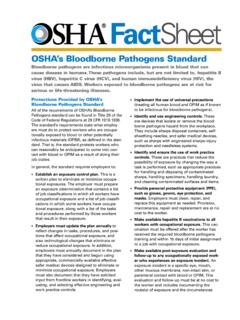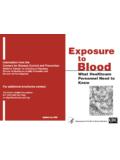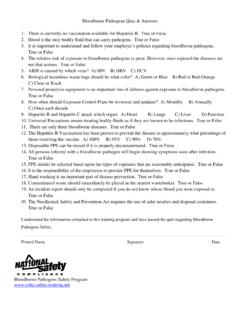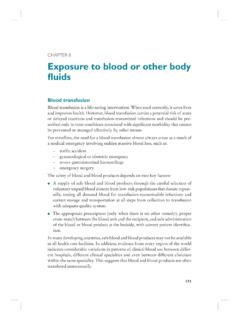Transcription of Outpatient Guide Checklist - Centers for Disease Control ...
1 Guide TO INFECTION PREVENTION FOR Outpatient SETTINGS: MINIMUM EXPECTATIONS FOR SAFE CAREN ational Center for Emerging and Zoonotic Infectious DiseasesDivision of Healthcare Quality PromotionVersion - September 20162 Version - September 2016 This page left intentionally - September 2016 APPENDIX A: INFECTION PREVENTION Checklist FOR Outpatient SETTINGS This Checklist is a companion to the Guide to Infection Prevention for Outpatient Settings: Minimum Expectations for Safe Care and is intended to assist in the assessment of infection Control programs and practices in Outpatient settings. The Checklist should be used:1. To ensure that the facility has appropriate infection prevention policies and procedures in place and supplies to allow healthcare personnel (HCP) to provide safe To systematically assess personnel adherence to correct infection prevention practices. In order to complete the assessment, direct observation of infection Control practices will be necessary.
2 Providers using this Checklist should identify all procedures performed in their facility and refer to appropriate sections to conduct their evaluation. Certain sections may not apply ( , some settings may not perform sterilization or high-level disinfection). If the answer to any of the listed questions is No, efforts should be made to correct the practice, appropriately educate HCP (if applicable), and determine why the correct practice was not being performed. Consideration should also be made for determining the risk posed to patients by the deficient practice. Certain infection Control lapses ( , re-use of syringes on more than one patient or to access a medication container that is used for subsequent patients; re-use of lancets) have resulted in bloodborne pathogen transmission and should be halted immediately. Identification of such lapses warrants immediate consultation with the state or local health department and appropriate notification and testing of potentially affected 1: Facility DemographicsSection 2: Infection Control Program and InfrastructureSection 3: Direct Observation of Facility PracticesSection 4: Infection Control Guidelines and Other Resources4 Version - September 2016 Infection Control Domains for Gap AssessmentI.
3 Infection Control Program and InfrastructureII. Infection Control Training and CompetencyIII. Healthcare Personnel SafetyIV. Surveillance and Disease Hand Personal Protective Equipment (PPE) Injection Safety (if applicable) Respiratory Hygiene/Cough Point-of-Care Testing (if applicable) Environmental Device ReprocessingXII. Sterilization of Reusable Devices (if applicable)XIII. High-level Disinfection of Reusable Devices (if applicable)5 Version - September 2016 Section 1: Facility DemographicsQuestionsDetailsIs the facility licensed by the state? Yes No If yes,Date of last inspection: _____Were any infection Control deficiencies identified during last inspection? Yes No If Yes, ensure those elements are evaluated during the assessment. Is the facility certified by the Centers for Medicare & Medicaid Services (CMS)? Yes No If yes,Date of last inspection: _____Were any infection Control deficiencies identified during last inspection?
4 Yes No If Yes, ensure those elements are evaluated during the the facility accredited? Yes No If yes, List the accreditation organization: Accreditation Association for Ambulatory Health Care (AAAHC) American Association for Accreditation of Ambulatory Surgery Facilities (AAAASF) American Osteopathic Association (AOA) The Joint Commission (TJC) Other (specify): _____Date of last inspection: _____Were any infection Control deficiencies identified during last inspection? Yes No If Yes, ensure those elements are evaluated during the the facility affiliated with a hospital? Yes No If yes, consider engaging with the hospital infection prevention program for assistance in remediation of any identified procedures are performed by the facility?Select all that , Endoscopy, Ear/Nose/ThroatImaging (MRI/CT), Immunizations, OB/GynOphthalmologic, Orthopedic, Pain remediationPlastic/reconstructive, Podiatry, Other (specify) Chemotherapy Imaging (MRI/CT) Ophthalmologic Plastic/reconstructive Endoscopy Immunizations Orthopedic Podiatry Ear/Nose/Throat OB/Gyn Pain remediation Other (specify)6 Version - September 2016 Section 2: Infection Control Program and InfrastructureI.
5 Infection Control Program and InfrastructureElements to be assessedAssessmentNotes/Areas for ImprovementA. Written infection prevention policies and procedures are available, current, and based on evidence-based guidelines ( , CDC/HICPAC), regulations, or : Policies and procedures should be appropriate for the services provided by the facility and should extend beyond OSHA bloodborne pathogens training Yes NoB. Infection prevention policies and procedures are re-assessed at least annually or according to state or federal requirements, and updated if appropriate. Yes NoC. At least one individual trained in infection prevention is employed by or regularly available ( , by contract) to manage the facility s infection Control : Examples of training may include: Successful completion of initial and/or recertification exams developed by the Certification Board for Infection Control & Epidemiology; participation in infection Control courses organized by the state or recognized professional societies ( , APIC, SHEA).
6 Yes NoD. Facility has system for early detection and management of potentially infectious persons at initial points of patient : System may include taking a travel and occupational history, as appropriate, and elements described under respiratory hygiene/cough etiquette. Yes NoII. Infection Control Training and Competency Elements to be assessedAssessmentNotes/Areas for ImprovementA. Facility has a competency-based training program that provides job-specific training on infection prevention policies and procedures to healthcare : This includes those employed by outside agencies and available by contract or on a volunteer basis to the sections below for more specific assessment of training related to: hand hygiene, personal protective equipment (PPE), injection safety, environmental cleaning, point-of-care testing, and device reprocessing. Yes No7 Version - September 2016 III. Healthcare Personnel SafetyElements to be assessedAssessmentNotes/Areas for ImprovementA.
7 Facility has an exposure Control plan that is tailored to the specific requirements of the facility ( , addresses potential hazards posed by specific services provided by the facility).Note: A model template, which includes a Guide for creating an exposure Control plan that meets the requirements of the OSHA bloodborne pathogens Standard is available at: Yes NoB. HCP for whom contact with blood or other potentially infectious material is anticipated are trained on the OSHA bloodborne pathogens standard upon hire and at least annually. Yes NoC. Following an exposure event, post- exposure evaluation and follow-up, including prophylaxis as appropriate, are available at no cost to employee and are supervised by a licensed healthcare : An exposure incident refers to a specific eye, mouth, other mucous membrane, non-intact skin, or parenteral contact with blood or other potentially infectious materials that results from the performance of an individual s duties.
8 Yes No D. Facility tracks HCP exposure events and evaluates event data and develops/implements corrective action plans to reduce incidence of such events. Yes NoE. Facility follows recommendations of the Advisory Committee on Immunization Practices (ACIP) for immunization of HCP, including offering Hepatitis B and influenza : Immunization of Health-Care Personnel: Recommendations of the ACIP available at: Yes NoF. All HCP receive baseline tuberculosis (TB) screening prior to placement; HCP receive repeat testing, if appropriate, based upon the facility-level risk assessment. Note: For more information, facilities should refer to the Guidelines for Preventing the Transmission of Mycobacterium tuberculosis in Health-Care Settings, 2005 available at: Yes NoG. If respirators are used, the facility has a respiratory protection program that details required worksite-specific procedures and elements for required respirator use, including provision of medical clearance, training, and fit testing as appropriate.
9 Yes No Not applicable8 Version - September 2016 III. Healthcare Personnel Safety (continued) Elements to be assessedAssessmentNotes/Areas for ImprovementH. Facility has well-defined policies concerning contact of personnel with patients when personnel have potentially transmissible conditions. These policies include:i. Work-exclusion policies that encourage reporting of illnesses and do not penalize with loss of wages, benefits, or job Education of personnel on prompt reporting of illness to supervisor. Yes No Yes No Yes NoIV. Surveillance and Disease ReportingElements to be assessedAssessmentNotes/Areas for ImprovementA. An updated list of diseases reportable to the public health authority is readily available to all personnel. Yes NoB. Facility can demonstrate knowledge of and compliance with mandatory reporting requirements for notifiable diseases, healthcare associated infections (as appropriate), and for potential outbreaks. Yes NoC.
10 Patients who have undergone procedures at the facility are educated regarding signs and symptoms of infection that may be associated with the procedure and instructed to notify the facility if such signs or symptoms occur. Yes No9 Version - September Hand HygieneElements to be assessedAssessmentNotes/Areas for ImprovementA. All HCP are educated regarding appropriate indications for hand hygiene:i. Upon hire, prior to provision of careii. Annually Yes No Yes NoB. HCP are required to demonstrate competency with hand hygiene following each training. Yes NoC. Facility routinely audits (monitors and documents) adherence to hand hygiene. Yes NoD. Facility provides feedback from audits to personnel regarding their hand hygiene performance. Yes NoE. Hand hygiene policies promote preferential use of alcohol-based hand rub over soap and water in most clinical situations. Note: Soap and water should be used when hands are visibly soiled ( blood, body fluids) and is also preferred after caring for a patient with known or suspected C.












